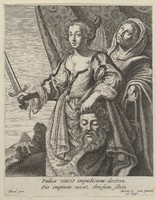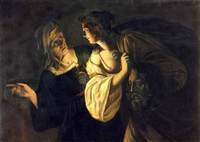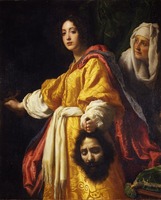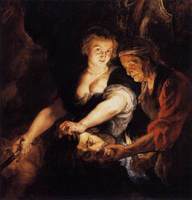Early 17th Century
A woman with curls pinned into an elaborate updo holds the severed head of an older bearded man. Just as she, the head faces the viewer directly, but with eyes closed. The woman is dressed in a luxurious, 17th century gown with many intricate patterns and details. She is holding the head by the hair in her left hand, the right of which holds a sword. Behind the sword is a setting of a pastoral landscape with rolling hills. Next to her is a woman dressed more understated with a modest headwrap. She looks up to the heavens, almost as if to ask for penance for the crime she has helped commit (but more likely thanking the heavens that the evil holding her city hostage has been slain).
During his lifetime, Pierre Mariette assembled one of history's finest collections of drawings, amassing over nine thousand sheets. He was born the heir to a well-established dynasty of printmakers, publishers, and print dealers from Paris.
A woman with bright, pale skin is at the foreground, nearly coming off of the canvas. She stands out starkly in the scene with her pale skin, and has a curly auburn updo accented with silk ribbons and pearls, the white sleeve of her blue gown falling off of her shoulder along with her red cloak. She looks away from the head of an older bearded man she holds in her left hand, a sword held in her right. In the shadows is her maidservant, a modest woman with a white headwrap, face obscured by the woman in the foreground's shadow; she looks up to the heavens, mouth slightly agape in an expression of shock.
Giuseppe Cesari, the son of a painter, was born in 1568, likely in the town of Arpino, located between Rome and Naples. He was apprenticed to Nicolò Circignani around 1582, in which he participated in the decoration of the Logge of Gregory XIII in the Vatican and in subsequent projects executed by groups of artists working under Circignani's direction. His early works were characterized by the soft, near transparent colors. He went on to become the most prominent painter in Rome, going on to teach artists such as Caravaggio and Caracci (the former of whom painted his rendition of Judith and Holofernes in 1598-99.
Unlike many other interpretations of Judith beheading Holofernes, Cesari's version simply alludes to the violent act. He depicts Judith as an almost demure figure figure, the embodiment of female virtue and moral perfection, an ideal heroine who has redeemed her people from the clutches of the Assyrian army. Yet she has agency over her sexual allure, suggesting that she wields not one, not two, but three dangerous weapons: her sword, her beauty, and her sexual allure.
Two women flee through the night, illuminated by candlelight. The woman on the left is who holds their lightsource, she is an elderly woman wearing a dark gown and white headwrap, and is gesturing to the right (supposedly toward their destination). The woman at her side maintains eye contact with her as she does so, she is a younger woman with curly auburn hair pulled away from her face in a simple updo. The white underdress of her mustard gown slips off her right shoulder, the hand of which she holds the severed head of an older, bearded man.
Gerard Seghers was born in 1591 in Antwerp, Germany. He was registered in 1603, at the age of twelve, as an apprentice at Saint Luke's Guild in Antwerp, and became an independent master in 1608. He lived in Italy during the 1610s, in which he lived with and studied the works of other artists such as Bartolomeo Manfredi, an important student of Caravaggio. Upon his return to Antwerp in the fall of 1620, he assisted Peter Paul Rubens the following year in the decoration of the Jesuit church (of whom painted his rendition of Judith and Holofernes in 1616).
In his years in Italy, Gerard Seghers conformed to the Tenebrist style. From this period the only painting securely attributed to him was Judith with the Head of Holofernes, of which is completely in line with the contemporary work of Caravaggio's first followers.
A woman with dark ringlets framing her face holds the severed head of Assyrian general Holofernes in her left hand, the other holding onto what appears to be the hilt of a sword. The woman wears a luxurious gold gown, with red, white, and blue accents. Her maidservant, who is to her left with a white wrap around her head, looks at her with brows furrowed. As her maidservant looks at her in what appears to be disbelief, the woman looks at the viewer stoically.
Cristofano Allori was born in Firenze, Italy in 1577. Of his extensive portfolio, Judith with the Head of Holofernes is considered his most famous painting. His interpretation of the biblical story of Judith and Holofernes was autobiographical; the decapitated head of Holofernes is a self-portrait while his lover Mazzafirra is portrayed in the beautiful face of the heroine; the luxurious clothing Judith wears is a tribute to the city's thriving textile industry.
Allori emphasizes the heroine's beauty by contrasting it against the horror of the decapitated head she is holding. He depicts her as having great pride in her deed, and assured of her divine protection. The positioning of Holofernes' head makes it appear as though it is about to emerge into the space of the viewer, adding to the emotional intensity of the painting. The rich colors and skilled execution of texture and form are characteristic of the Florentine artist.
This work is a testament to Allori's Caravaggian influence through the teachings of Artemisia Gentileschi, who also painted two interpretations of the story in the same period.
A woman looks directly at the viewer. She is illuminated by a single candle held below her by an elderly woman wearing a white headwrap and red garments. She is wearing a blue gown with a white underdress which is falling, exposing her breasts, auburn hair pulled away from her face in a simple updo. In her left hand she holds the severed head of an older bearded man with dark hair, and in her right is the sword that killed him. Her assertive gaze and mild smirk, illuminated from underneath, gives the scene an eerie ambience.
Peter Paul Rubens was born in 1577 in Siegen, Germany. He was a prolific seventeenth-century Flemish Baroque painter, his particular style emphasizing movement, color, and sensuality. He ran a large studio in Antwerp which produced paintings popular among the nobility and art collectors throughout Europe, and was knighted by both Philip IV, king of Spain, and Charles I, king of England.
From 1616 onward Rubens was able to illustrate dramatic scenes with a reliance on Caravaggian dramatic contrasts of light. His Judith with the Head of Holofernes is an excellent representation of this Caravaggian influence as well as his distinct Baroque style.




